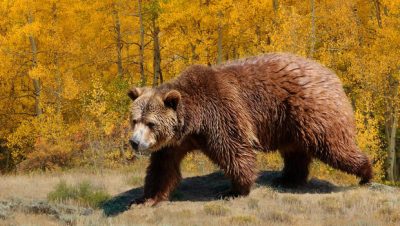Wildlife and Animal Rights: US Court Blocks Planned Yellowstone Grizzly Bear Trophy Hunts
Hunts blocked for at least 14 days

Note to readers: please click the share buttons above
Today, a U.S. District Court judge granted wildlife advocates’ motion for a temporary restraining order to block planned grizzly bear trophy hunts in Idaho and Wyoming for at least 14 days. This came after a hearing regarding a high-profile case over the U.S. Fish and Wildlife Services’ 2017 decision to strip grizzly bears in the Greater Yellowstone Ecosystem of vital Endangered Species Act protections, and provides the court time to deliberate on the merits of the case.
“We’re profoundly relieved the grizzly bears got a stay of execution today,” said Bethany Cotton with WildEarth Guardians. “We look forward to the judge’s thorough findings on all of the myriad flaws in the government’s approach to grizzly bear management in Greater Yellowstone.”
In the order, the court wrote that the plaintiffs’ arguments raise “serious questions going to the merits.” At minimum, the current issue is extremely similar to that recently presented in Humane Society of the United States v. Zinke, 865 F.3d 585 (D.C. Cir. 2017), in which the D.C. Circuit Court of Appeals held that Fish and Wildlife Service violated the Administrative Procedure Act and the Endangered Species Act when it isolated and delisted a distinct population segment without considering the legal and functional impact on the remainder of the species.
“We applaud Judge Christensen’s decision to hit the pause button,” said Matthew Bishop, an attorney with the Western Environmental Law Center. “There is simply no need to rush into a grizzly bear hunt, with potentially devastating consequences for this iconic species, when the merits of that hunt are being reviewed in federal court.”
Grizzlies in the Yellowstone region remain threatened by dwindling food sources, climate change, small population size, isolation, habitat loss and fragmentation, and high levels of human-caused mortality. The Yellowstone population is isolated and has yet to connect to bears elsewhere in the U.S., including to bears in and around Glacier National Park. Grizzlies also have yet to reclaim key historic habitats, including the Bitterroot Range along the Montana-Idaho border.
Hunted, trapped, and poisoned to near extinction, grizzly bear populations in the contiguous U.S. declined drastically from nearly 50,000 bears to only a few hundred by the 1930s. In response to the decline, the Service designated the species as threatened under the Endangered Species Act in 1975, a move that likely saved them from extinction. The species has since struggled to hang on, with only roughly 1,800 currently surviving in the lower 48 states. Grizzlies remain absent from nearly 98 percent of their historic range. Last year (2017) marked the highest mortality for the Greater Yellowstone Ecosystem’s grizzlies since their ESA listing.
Grizzly bear mortality in 2018 is proceeding at a record pace, even without the added mortalities from trophy hunting which would have claimed up to 22 more. At last count, approximately 690 grizzly bears resided in the Greater Yellowstone region, down from 2015’s count of 717 bears. The last three years had near record-breaking grizzly mortality, with at least 41 bears killed in 2017, and an additional 15 listed as probable mortalities. Of this, at least 32 were killed by humans, and humans were responsible for at least 9 of the 15 probable deaths. As of this writing, 34 grizzlies are on the 2018 known and probable mortalities list for the Greater Yellowstone ecosystem, far outpacing previous years’ rates.

